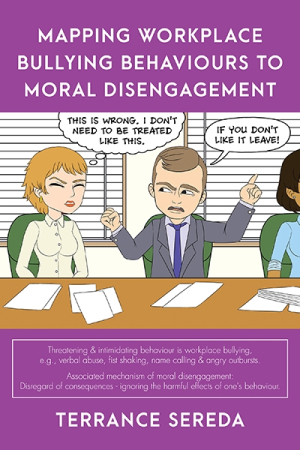
Mapping Workplace Bullying Behaviours to Moral Disengagement
This specialized and scholarly text explores the whys of workplace bullying.
Terrance Sereda’s research-based Mapping Workplace Bullying Behaviours to Moral Disengagement examines how individuals rationalize workplace bullying.
Sereda, a scientist, applies his research and analytical skills to creating awareness around workplace bullying. This book cites numerous sources, though it hastens to point out that it is a “theoretical discussion” rather than a quantitative study. Uniquely, it approaches the subject from the perpetrator’s point of view, exploring in some detail how bullying is rationalized. This approach is refreshing and proffers valuable insights into what factors or conditions might influence bullying.
Beginning with its useful definition and overview of workplace bullying, the book commands interest by positioning the issue as complex. It argues that workplace bullying is often broader than a single incident and can be caused by “a range of circumstances” within the workplace. The book’s description of bullying behaviors, which are outlined in bulleted form, is a strong point; it isolates bullying behaviors and provides brief illustrations of how each behavior manifests itself. This portion of the book should be useful to researchers and business managers alike.
“Moral disengagement” and its “eight mechanisms” are addressed in a way that adds academic value to the subject; however, multiple citations and unusual terminology make the information difficult to navigate. A helpful table enumerates the eight mechanisms and describes each with solid examples and is more easily understood. Bullying behaviors are categorized along a spectrum of seven specific behaviors; they should be of particular interest to concerned managers who need a better understanding of the problem.
A lengthy, thoroughly cited discussion works to tie the sections together, though it is overly academic in tone. The conclusion summarizes the book’s content nicely and interprets all included research to suggest how perpetrators of workplace bullying most often operate. References are helpfully listed at the end of the book and are a credible and authoritative mix.
The book is well organized into sections that flow logically from one to the other. The writing is generally clear yet is scholarly in nature. The book has the overtone of a research study and, as such, could be perceived by general readers as detailed and dry.
Mapping Workplace Bullying Behaviours to Moral Disengagement is a specialized work likely to be most appealing to academics and researchers. Its important information about workplace bullying will be relevant for business managers.
Reviewed by
Barry Silverstein
Disclosure: This article is not an endorsement, but a review. The publisher of this book provided free copies of the book and paid a small fee to have their book reviewed by a professional reviewer. Foreword Reviews and Clarion Reviews make no guarantee that the publisher will receive a positive review. Foreword Magazine, Inc. is disclosing this in accordance with the Federal Trade Commission’s 16 CFR, Part 255.
